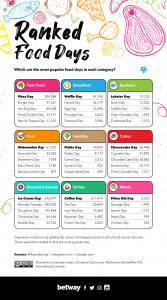 Every year, the Food and Agriculture Organization (FAO) of the United Nations commemorates October 16 as World Food Day – the day this organization was founded in 1945. World Food Day is celebrated in 150 countries. The focusison promoting proper nutrition that’s supposed to be available and accessible to all. The ultimate goal is to reduce the number of hungry in the world.
Every year, the Food and Agriculture Organization (FAO) of the United Nations commemorates October 16 as World Food Day – the day this organization was founded in 1945. World Food Day is celebrated in 150 countries. The focusison promoting proper nutrition that’s supposed to be available and accessible to all. The ultimate goal is to reduce the number of hungry in the world.
Over the past decades, there has been a dramatic shift in the diet as a result of urbanization, the globalization of the world food market, as well as demographic and economic changes. The traditional diet, which involved the use of foods that seasonally grow in a particular climate, has been replaced by the diet characterized by high-energy and low-nutritional intake. Dominant in the diet of modern humans are sugars, fats, industrially produced food, meat and meat products, and semi-finished and finished meals.
What Do We Eat Most Now?
The research proved this claim. While trying to figure out which food days are most popular in the world, Betway composed a unique scoring system based on UK and US search volumes to which Instagram posts were added. The ranking that emerged from that showed that only one healthy food day found its way in the top 10 food days and that’s National Watermelon Day (#10).
Increasingly, we eat at least one meal during the day outside the home and we prepare food only on weekends. Regarding their choice of food, consumers in urban areas mostly rely on supermarkets, fast food kiosks or ordering a takeaway. So, it’s no surprise that overweight and obesity are taking their toll. The obesity pandemic in numbers means that today over 670 million adults and over 120 million children between the ages of 5 and 19 are obese in the world.
At the same time, after a period of decline, the frequency of hunger in the world is rising again, so new data indicates that over 820 million people in the world are hungry. According to the latest FAO report, more than 815 million people today suffer from chronic malnutrition, of which 60% are women.
Why’s Proper Nutrition Important?
Eating properly means providing the body with all the nutrients and protective substances it needs for optimal functioning of all cells and tissues, as well as a strong shield against infections. The importance of proper nutrition is indicated by the number of diseases resulting from improper nutrition.
Obesity, high blood pressure, high blood fat, and diabetes are just some of the many health disorders that are on the basis of an inadequate diet. And this number has, unfortunately, been steadily increasing over the last decades.
Proper Nutrition Advice
Proper nutrition advice would include the following: regular meals, proper choice of the type of foods, and how to prepare them. Instead of white bread and pastry, preference should be given to bread made from whole-grain cereals (in addition to optimal nutritional value, it also contains dietary fiber important for regulating bowel movements.
It’s advisable to exclude snacks, but also puff pastry and all pastries – because of the saturated fat content. Cereals can be used as a supplement to soups or stews instead of pasta, or as a side dish with meat/fish and vegetables. They contain complex sugars that provide sufficient satiety on one side and also contain enough fibrous matter to provide better bowel movements.
When it comes to milk and dairy products, it’s useful to avoid butter, cream, sour cream, cream cheese, cheese spreads, margarine, etc. in your daily diet. It’s also recommended to use seasonal fruits and vegetables, the more diverse the better. When it comes to meat, fish and meat products, offal and dried meat products should be avoided, and fish and white chicken or white turkey meat should be preferred. It’s important to remove the skin from poultry meat and visible fat (white parts) from other types of meat.
Sufficient fluid intake is also important, especially water and herbal teas, 2 l – 2.5 l daily. The diet depends on age, gender, health, the type of work the person is doing, and physical activity throughout the day, so these general principles are also adapted to individual needs.

